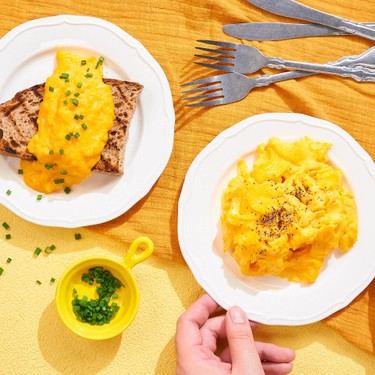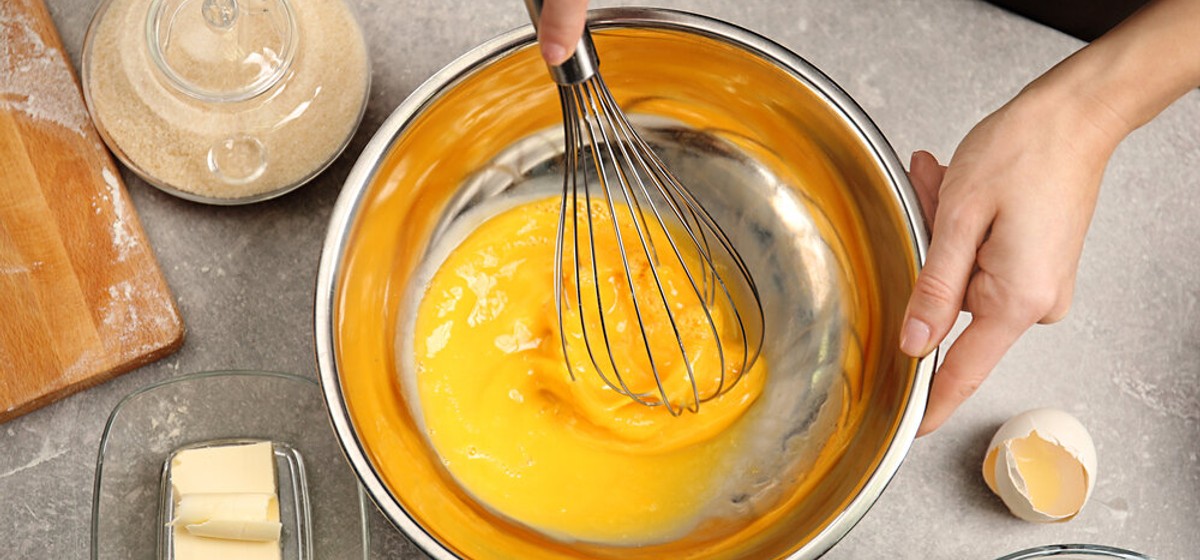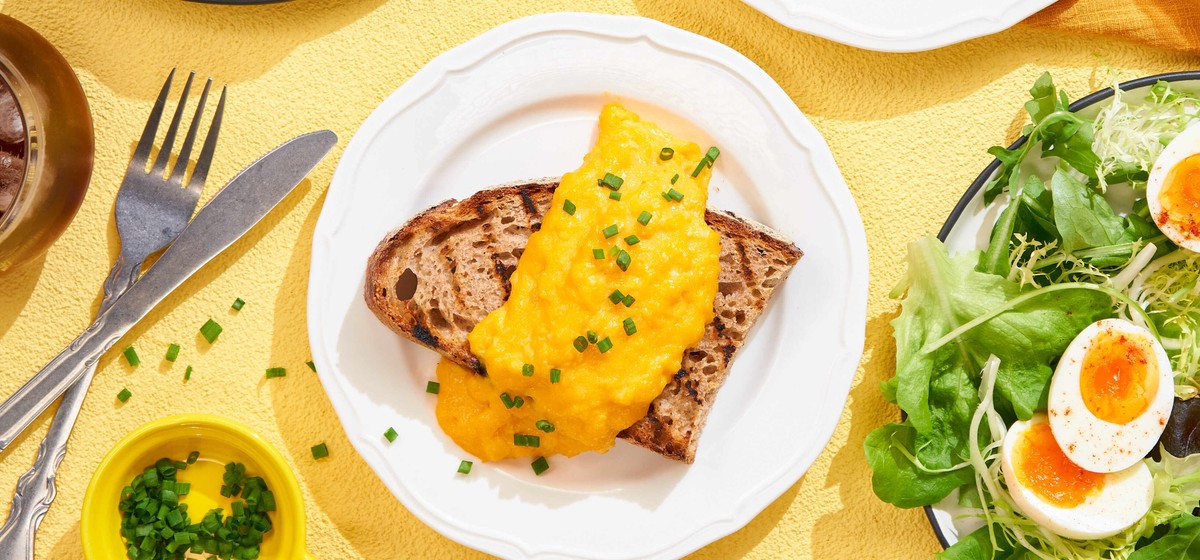We Tried 50 Times and Here's How to Make Perfect Scrambled Eggs




Scrambled eggs are the undeniable champions of breakfast and brunch. The soft velvety egg curds on top of crunchy toast or next to a couple of strips of bacon might be one of the most popular ways to make eggs.
It might seem like an easy dish, but it’s trickier than you think. How hard is it to beat some eggs and throw them into a non-stick frying pan? Well, if you have ever tried to find the best way to make scrambled eggs, you know how many different, often conflicting cooking methods, hacks, and tricks are out there. Not to mention the next-level scrambled eggs Gordon Ramsey made famous.
We have gathered the most popular cooking tips and tricks for a perfect egg scramble and tested it all at SideChef’s kitchen, so you don’t have to go through lengthy research looking for the softest, creamiest, and fluffiest scrambled eggs recipe.
A universal recipe doesn’t exist, but you can learn how to make scrambled eggs perfect for your taste buds from this eggs-pert study we have conducted. Here is all you need to know about making scrambled eggs.
Actually, you can check out our ultimate video guide to cooking eggs too.
Most chefs, culinary enthusiasts, and home cooks agree that using a whisk and a nonstick skillet can make scrambled eggs noticeably better. But when it comes to choosing the absolute best way to make a soft and fluffy scramble, everyone has their cooking method or hack.
Let’s not get lost in all the scrambled egg recipes and start from the very basics. Generally, there are three main cooking styles you can choose from: hard scrambled eggs, soft scrambled eggs, and French-style scrambled eggs. Choose the one for you.
Hard scrambled eggs are the kind you usually get at a classic American diner. This way of cooking is the fastest and easiest.
Some might call this way borderline lazy because it doesn’t need vigorous whisking or constant stirring. There are no extra ingredients in a hard scramble, just fresh eggs, some oil for the pan (melted butter or olive oil), and seasoning (salt and pepper).
In a hard scramble, the eggs are fully cooked into large soft curds. The whites and the egg yolks are not thoroughly mixed so that you can see the strains of whites in them. You simply crack the eggs directly into the pan and stir them together as they solidify. This method only takes 2-3 minutes.
These eggs are more on the dry side; they are fluffy but don’t expect velvety or creamy texture if you use this method.
Soft scrambled eggs are the velvety, creamy kind that requires a bit more effort, some extra ingredients, and a smidge of culinary technique.
A soft scramble is also the recipe everyone keeps arguing about. Some say adding water, milk, or cream is a must; others add extra butter; suggest adding sour cream. And the “when should you season scrambled eggs” debate will never be over.
In general, soft scrambled eggs need to be whisked before transferring them into a pan and then constantly stirred, allowing them to form smaller curds. They are not fully cooked and have a moist creamier texture.
Soft scrambled eggs are the kind most of us would like to perfect. And with all the different recipes, “secrets,” tips, and tricks, it’s easy to get confused. We have tried most of them, and here is what we found out.
There are even arguments about the kitchen tools one needs to make a perfect soft scramble successfully. Some culinary experts claim that even a whisk is not good enough, and you must use an immersion blender.
We found that to make the soft and fluffy scrambled eggs, you need three tools:

There are two opposite opinions on when it is best to add salt to scrambled eggs. We belong to the “salt your eggs before whisking” club, and here’s why:
For next-level soft scrambled eggs, whisk in salt 10 minutes before cooking them.

Go for a medium-low setting on the stove. It should take you about 5-6 minutes to cook a velvety soft scramble on this setting.
Make sure to keep an eye on the eggs and stir constantly, but not too vigorously. Give some time for small eggy curds to form, and swirl them around, mixing the bottom layer with the uncooked eggs on top.
How often you run a spatula defines the size of the egg curds in your scramble. Stir too much and too vigorously, and the eggs will be too loose (which is also acceptable if that’s what you want, but then you should consider making French-style scrambled eggs instead).
You must know when to take the eggs off the heat so as not to overcook them. When you want to get a perfect velvety, creamy soft scramble, you should take it off the heat when it still looks a little bit undercooked.
When it looks almost done, but you still have some gooey uncooked eggs on top, it’s time to take it off the heat and let the residual heat finish the cooking. Otherwise, you will end up with watery rubbery curds.

Adding just enough butter and cream takes soft scrambled eggs from just good to next-level excellent. Butter and cream add extra fat to the scramble, which is always good when you want that soft and silky texture. But it’s essential to do it just right.
After trying every ratio we thought could influence the texture, we came up with the golden ratio of butter and cream to eggs for a perfect soft scramble every time.
Use 1 tbsp. of butter and 1 tbsp. of cream for every 2 eggs you scramble.
The extra fat from butter and cream makes eggs more tender and gooey. What you should remember is that they also add water. More water content and you may end up with the opposite of what you were aiming for. And here is why you should go back to the previous point - do not leave the eggs cooking for too long. If you add extra cream and butter, take them off heat, still slightly undercooked.
There are plenty of delicious extras you can mix into your scramble. Still, all of them must be thoroughly cooked before you fold them into the eggs, especially if you’d like to add anything with high water content, like vegetables. Let’s look at more possible extras for a scramble:
Step 1: Crack a desired number of eggs into a bowl.
Step 2: Season the eggs, add the heavy cream, and whisk thoroughly until completely blended.
Step 3: Let the egg mixture rest for a few minutes.
Step 4: Meanwhile, preheat your nonstick skillet over medium-low heat and toss in enough butter to cover its surface.
Step 5: Pour in the eggs and start stirring and moving them around, letting those velvety curds form. Be patient.
Step 6: Take the eggs off the heat when they still look slightly undercooked and let the residual heat finish the job.
If you follow all of the above, you are guaranteed to have perfect scrambled eggs every single time.

French scrambled eggs are soft, custardy, and can be eaten with a spoon. This scramble is the most delicate, creamiest, and the most elevated “chef”- level kind and requires all of your attention and quite a bit of your time (20 minutes on average).
French scrambled eggs are made with butter and heavy cream or crème fraîche over low, the lowest possible heat. You have to stir the eggs constantly, even when it seems like nothing is happening until tiny curds start to form into a silky, custard-like scramble. Once the mix is thick enough, you take it off the heat and add that extra cream.